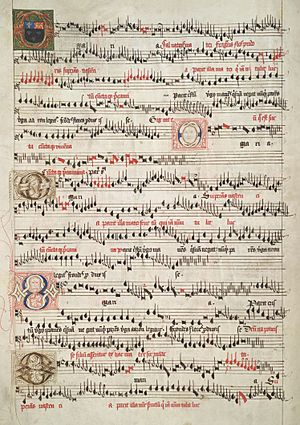John Browne (composer) facts for kids
John Browne (born 1453, died around 1500) was an English composer from the Tudor period. He was very skilled, but sadly, not much of his music is still around today. Most of his surviving works are found in a special book called the Eton Choirbook. He has more music in this book than any other composer! Some of his music is also in the Fayrfax Manuscript. Browne's choral music (music for choirs) is known for its unique sounds and long, flowing melodies. One music expert, Peter Phillips, even called his music "subtle, almost mystical" and "extreme."
The Life of John Browne
Not much is known about John Browne's life. We believe he was born in Coventry, a city in England. In July 1467, a John Browne from Coventry became a student at Eton College. He was about 14 years old at the time. He was a bit younger than another composer, Walter Lambe, who was probably also at Eton then. After his time at Eton, we don't know what happened in his career or when he died.
Browne's Unique Music Style
All of John Browne's music that we still have today is found in the older parts of the Eton Choirbook. These parts were created between 1490 and 1500. The Choirbook's list of contents shows that ten more of Browne's pieces were originally included. Sadly, five of these are now lost, and two only exist in small pieces.
Browne's music is special because he used different and unusual groups of voices. Each of his surviving pieces uses a unique combination of singers. No two of his compositions use the exact same setup! For example, his six-voice song Stabat iuxta was written for a choir with four tenors and two basses. This was a very unusual mix for his time.
His choral music often shows how carefully he used the words of the songs to create drama. He also used imitation (where one voice copies another) and dissonance (sounds that clash a little, but in an interesting way) to add expression. The song Stabat iuxta is known for its "dense, almost cluster chords" and "harsh" false relations. Other pieces have a wide range, with low voices supporting high, soaring soprano lines.
Even though Browne didn't write as many pieces as some composers from other countries, his works are very powerful and often quite long. Some can take about 15 minutes to perform! Many composers in the Eton Choirbook are only known from this one book. This is because many Catholic music books were destroyed during the time of King Henry VIII. We may never know how much music Browne and other English composers from that time actually created.
List of Browne's Works
Here are some of the musical pieces by John Browne that we know about:
- O Maria salvatoris mater
- Stabat mater dolorosa
- Stabat virgo mater Christi
- Stabat juxta Christi crucem
- O regina mundi clara
- Salve regina mater misericordiae (There are two different versions of this one!)
- Ave lux totius mundi (This piece is now lost)
- Gaude flore virginali (This piece is also lost)
- O mater venerabilis
- Stabat virgo mater Christi
- Magnificat: Et exultavit spiritus meus (One version is lost, but others survive)
- Jesu, Mercy, How May This Be?


